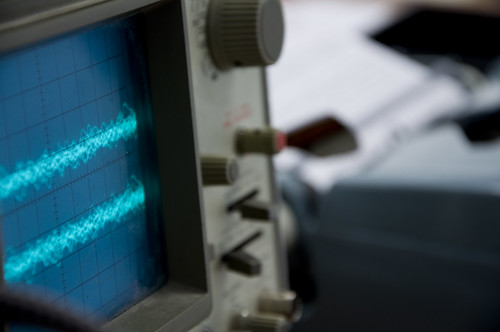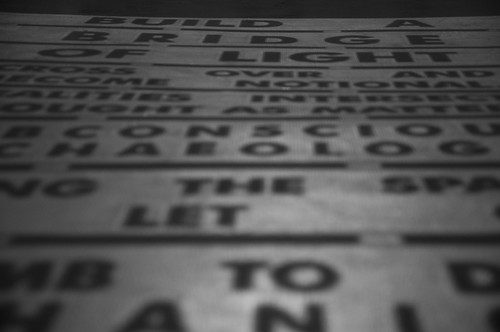Another little bit of cataloguing of process for degree show, I figured it might be of interest to put together a collection of quotes which I feel go some ways to mapping my inspirations, thought patterns and processes. The list appears in no specific order other than that in which they come back to me. But first, here are some little teaser images of how the installation is progressing.




A little more here.
QUOTES:
Here follows a small selection of quotes that I feel have particular resonance in the context of both my work and my general mental makeup.
“Hush; may I ask you all for silence?
The dreamer is still asleep
May the goddess keep us from single vision
And you to sleep
The dreamer is still asleep
The dreamer is still asleep
He’s inventing landscapes in their magnetic field
Working out a means of escape
We’ll cut across the crop circles”
Jhonn Balance, The Dreamer Is Still Asleep, 1999
“Sous les pavés, la plage”
Anon. 1968
“I believe in the light cast by video-recorders in department store windows, in the messianic insights of the radiator grilles of showroom automobiles, in the elegance of the oil stains on the engine nacelles of 747s parked on airport tarmacs.
I believe in the non-existence of the past, in the death of the future, and the infinite possibilities of the present.”
JG Ballard, What I Believe, 1984
“The road behind co-exists with the road ahead, we are Stokers’ undead, see nothing of ourselves in the rearview mirror. We see the tarmac ahead, we see the vanishing point, we travel on with only the radio for company, we move through space and time, memory receeds, we become cosmonaughts, we become lost.”
Iain Sinclair, Orbital, 2002
“And I asked myself about the present: how wide it was, how much was mine to keep”
Kurt Vonnengut, Slaughterhouse V, 1969
“Liat conceives a building that enfolds the road, a museum of memory. Sensors monitor traffic, affecting the fabric of the building, influencing the dreamers in their alcoves. The walls are thin as paper or they are thick as the masonry of the Tower of London. The wonder is that such resonant projects begin with a tatty map, rescued ephemera from a building that remains suspicious of its own legend.”
Iain Sinclair on Liat Uziel’s Museum of Memory, Orbital, 2002
“as so often, the archive, despite its plentitude and profusion, invokes what is missing rather than what is present.”
Michael Sheringham, Archiving (Restless Cities), 2010
“Perhaps this garden exists only in the shadow of our eyelids and we have never stopped…to ponder what we are seeing and living, to draw conclusions, to contemplate from the distance.”
Italo Calvino, Invisible Cities,1974
“I shall traverse my room up and down and across, without rule or plan. I shall even zig-zag about, following, if needs be, every possible geometrical line. I am no admirer of people who are such masters of their every step and every idea.”
Xavier De Maistre, A Journey Round My Room, 1871
“Perhaps we all lose our sense of reality to the precise degree to which we are engrossed in our own work, and perhaps that is why we see the increasing complexity of our mental constructs a means for greater understanding, even while intuiuively we know that we shall never be able to fathom the imponderables that govern our course through life.”
WG Sebald, Rings Of Saturn, 1995
“The Universe, which always was a computer, will, for one moment- not even that- be so dense and have so much energy that it will be able to compute anything atall. So why not simply program it to simulate a new one that will never end. This moment will be called Omega Point, and, because it has the power to contain everything, will be indistinguishable from God.”
Scarlett Thomas, Our Tragic Universe, 2010
“There’s a palace in your head boy. Learn to live in it always.[…] You don’t think this world is any less real than the one you left do you? Everything that ever happened to you is real, even your dreams. Them most of all. There are many worlds, many cities, and all of them are just shockwaves spreading out from one single moment of clarity and understanding. Ripples.”
Grant Morrison, The Invisibles, 1994
“You are living on a Plane. What you style Flatland is the vast level surface of what I may call a fluid, or in, the top of which you and your countrymen move about, without rising above or falling below it. I am not a plane Figure, but a Solid. You call me a Circle; but in reality I am not a Circle, but an infinite number of Circles, of size varying from a Point to a Circle of thirteen inches in diameter, one placed on the top of the other. When I cut through your plane as I am now doing, I make in your plane a section which you, very rightly, call a Circle. For even a Sphere–which is my proper name in my own country–if he manifest himself at all to an inhabitant of Flatland–must needs manifest himself as a Circle.
Do you not remember–for I, who see all things, discerned last night the phantasmal vision of Lineland written upon your brain–do you not remember, I say, how when you entered the realm of Lineland, you were compelled to manifest yourself to the King, not as a Square, but as a Line, because that Linear Realm had not Dimensions enough to represent the whole of you, but only a slice or section of you? In precisely the same way, your country of Two Dimensions is not spacious enough to represent me, a being of Three, but can only exhibit a slice or section of me, which is what you call a Circle.”
Edwin Abbott, Flatland, 1884
“Most people don’t consider the dimension of time in their lives because the way we live, we see sections of time. In order to get here, you had to come through that door so, can you point to coming through that door? In order to get here today you had to be 10 years old, can you point to being 10 years old? No you can’t because the way we experience time, we can only see it in memory, we can’t actually go there even though we know there is a place called the past where all this stuff happened, you can’t even point, you can’t show me a direction where the past is. think of yourself as the leading edge of you, this is you right now, moving forward through time but behind you there’s all these different versions of you going back and back and back. Imagine if you could see that in time, it wouldn’t just be a front and a back, it would be a long trailing thing and it contains all of you, it’s got all these arms and eyes and it moves backwards through the door and backwards down the stairs and it’s getting younger all the time through that trail but as I say, we can’t see that but if we could see it, it would look like a huge snake and it would keep going back and there are lots of these snakes and they all weave together and eventually you get ot be one year old somewhere in time, you are, right now, one year old because if you weren’t, you could be here today and that one year old dissapears back into its mother’s womb . And the same thing happens to your mother and father going back into their mother and father and you take it right back, everybody in the human race goes right back to the same human root and somewhere along the evolutionary tree we’re joined by apres but it’s all still the one thing and the tree is rooted 3 1/2 billion years ago in the ocean which is where the first living cell appeared and started to divide. The first mitochondria cell, the DNA cell is still dividing inside your body right now, it’s immortal, it never died, it never went anywhere, it just keeps dividing and making more copies of itself in all living forms so what we actually are is this amazing divided single cell which has grown itself across 3 1/2 billion years into a gigantic structure, I see it as an anemone.
If you can see the whole thing, if you can see life as a thing existing in time then there’s only this one huge thing that lives on the planet earth and feeds on the forests and feeds on itself, and that’s us, that’s what we really are.”
Grant Morrison, 2009
“Say its name, the absent town, the city in remove and there it rises in the backyard of our eyes, some common landmark, snapshot first, and then, specific street, and house, and room, specific chair. Say “Birmingham,” and the Rotunda rears within us, our imagination squinting in the traveller’s fair glare of Newstreet Station. Or say “Folkestone,” and recall the quayside’s sudden still beneath our feet. These are the towns of light, built from remembered brick, conjectured beam, that stand in Hilbert space, a plane of concept and idea where thought is form. Where the recalled smell of fresh paint upon forgotten stairs is an event in place and time. These detailed weightless urban sprawls we carry in our fragile skull, that teem with reminiscent traffics, populous with bias, opinion, rumour, legend, lie. Locations we shall never visit that yet have their hearsay substance in our lives, and so are never far from us. They rest in occult Mercators where distance is not marked from point to solid point, but calibrated there between the spark-gaps of our free associations, yielding geographies with Land’s End next to John O’ Groats, an Earth with poles adjacent. Continent, nation, mapped outside of matter, state of mind. Metropolis erected out of nothing, only metaphor, and ringed with slums of dream. Mnemonic highways made from smears of field glimpsed once through glass at speed, or from the jaundiced strobe of gone-by sodium lamps, hot amber necklace on the night’s bare throat, monoxide dabbed upon her pulse-points. Strung between the shimmering fabricated towns, inroads of anecdote, synaptic rails to bear the trains of thought, a beaded web across our gazetteer of the interior. Seen from above, the glittering threads of meaning run like mercury, converge on the imaginary capital, a shadow London, our idea of London, flickering in the forebrain. When we are not here, this apparition is our only London.”
Alan Moore, The Moon and Serpent Grand Egyptian Theatre of Marvels, 1994
D
